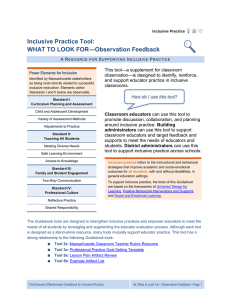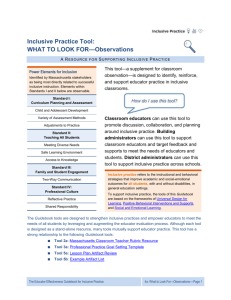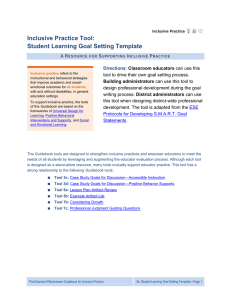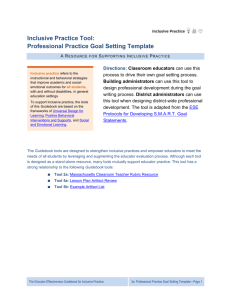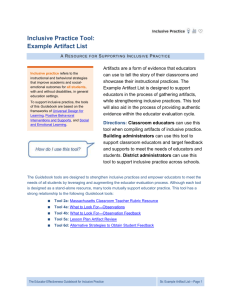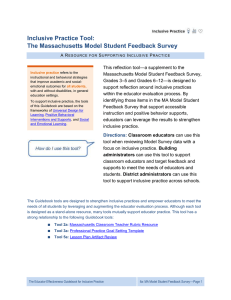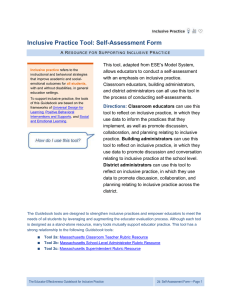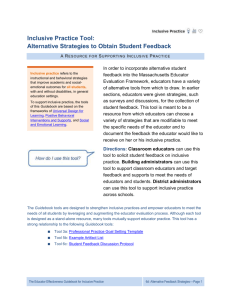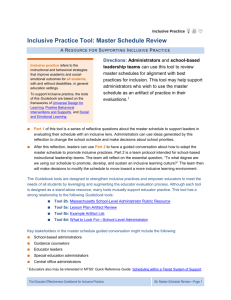Inclusive Practice Tool: Key Characteristics of Social and Emotional
advertisement
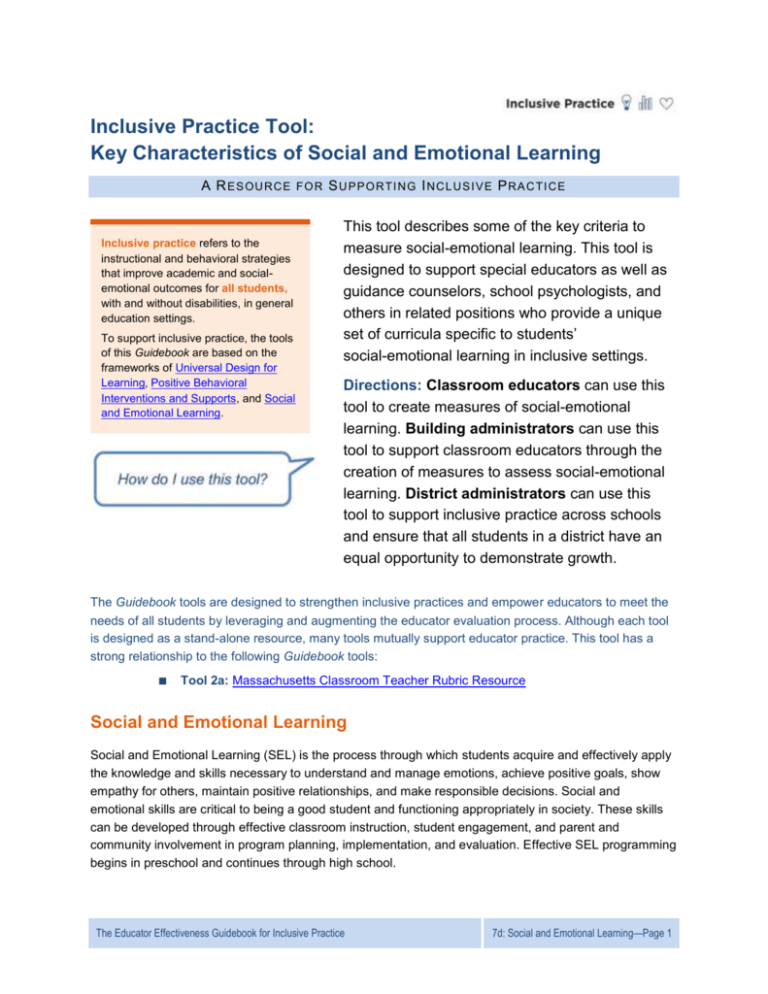
Inclusive Practice Tool: Key Characteristics of Social and Emotional Learning A R E S O U R C E F O R S U P P O R TI N G I N C L U S I V E P R A C TI C E Definition Inclusive practice refers to the instructional and behavioral strategies that improve academic and socialemotional outcomes for all students, with and without disabilities, in general education settings. To support inclusive practice, the tools of this Guidebook are based on the frameworks of Universal Design for Learning, Positive Behavioral Interventions and Supports, and Social and Emotional Learning. This tool describes some of the key criteria to measure social-emotional learning. This tool is designed to support special educators as well as guidance counselors, school psychologists, and others in related positions who provide a unique set of curricula specific to students’ social-emotional learning in inclusive settings. Directions: Classroom educators can use this tool to create measures of social-emotional learning. Building administrators can use this tool to support classroom educators through the creation of measures to assess social-emotional learning. District administrators can use this tool to support inclusive practice across schools and ensure that all students in a district have an equal opportunity to demonstrate growth. The Guidebook tools are designed to strengthen inclusive practices and empower educators to meet the needs of all students by leveraging and augmenting the educator evaluation process. Although each tool is designed as a stand-alone resource, many tools mutually support educator practice. This tool has a strong relationship to the following Guidebook tools: ■ Tool 2a: Massachusetts Classroom Teacher Rubric Resource Social and Emotional Learning Social and Emotional Learning (SEL) is the process through which students acquire and effectively apply the knowledge and skills necessary to understand and manage emotions, achieve positive goals, show empathy for others, maintain positive relationships, and make responsible decisions. Social and emotional skills are critical to being a good student and functioning appropriately in society. These skills can be developed through effective classroom instruction, student engagement, and parent and community involvement in program planning, implementation, and evaluation. Effective SEL programming begins in preschool and continues through high school. The Educator Effectiveness Guidebook for Inclusive Practice │7d: Social and Emotional Learning—Page 1 Key Characteristics of Social-Emotional Learning ■ Self-awareness: The ability to accurately recognize one’s emotions and thoughts and their influence on behavior. This includes accurately assessing one’s strengths and limitations and possessing a well-grounded sense of confidence and optimism. ■ Self-management: The ability to regulate one’s emotions, thoughts, and behaviors effectively in different situations. This includes managing stress, controlling impulses, motivating oneself, and setting and working toward achieving personal and academic goals. ■ Social awareness: The ability to take the perspective of and empathize with others from diverse backgrounds and cultures, to understand social and ethical norms for behavior, and to recognize family, school, and community resources and supports. ■ Relationship skills: The ability to establish and maintain healthy and rewarding relationships with diverse individuals and groups. This includes communicating clearly, listening actively, cooperating, resisting inappropriate social pressure, negotiating conflict constructively, and seeking and offering help when needed. ■ Responsible decision making: The ability to make constructive and respectful choices about personal behavior and social interactions based on consideration of ethical standards, safety concerns, social norms, the realistic evaluation of consequences of various actions, and the wellbeing of self and others.1 1 Image and descriptions from http://www.casel.org/social-and-emotional-learning/core-competencies. The Educator Effectiveness Guidebook for Inclusive Practice │7d: Social and Emotional Learning—Page 2 Massachusetts Comprehensive Health Curriculum Frameworks Educators can use the following core objectives from the Massachusetts Comprehensive Health Curriculum Frameworks to assess and monitor their students’ social-emotional learning progress. Core Objective Student(s) can identify basic emotions and feelings. (Mental Health 5.1) Student(s) can link current feelings to corresponding physical symptoms. (Mental Health 5.1) Student(s) understand and demonstrate character traits such as honesty, trustworthiness, self- discipline, respectfulness, and kindness. (Mental Health 5.3) Student(s) demonstrates decision-making skills within a team and cooperates with others. (Mental Health 5.4 and 5.5) Student(s) demonstrates coping skills effectively. (Mental Health 5.6 and 5.11) Student(s) applies both verbal and nonverbal communication skills to develop positive relationships and improve the social environment of the school. (Interpersonal Relationships 7.2) Student(s) can make and sustain friendships with others. (Interpersonal Relationships 7.3) Student(s) demonstrates respect and tolerance for individual differences. (Interpersonal Relationships 7.7) The Educator Effectiveness Guidebook for Inclusive Practice │7d: Social and Emotional Learning—Page 3
